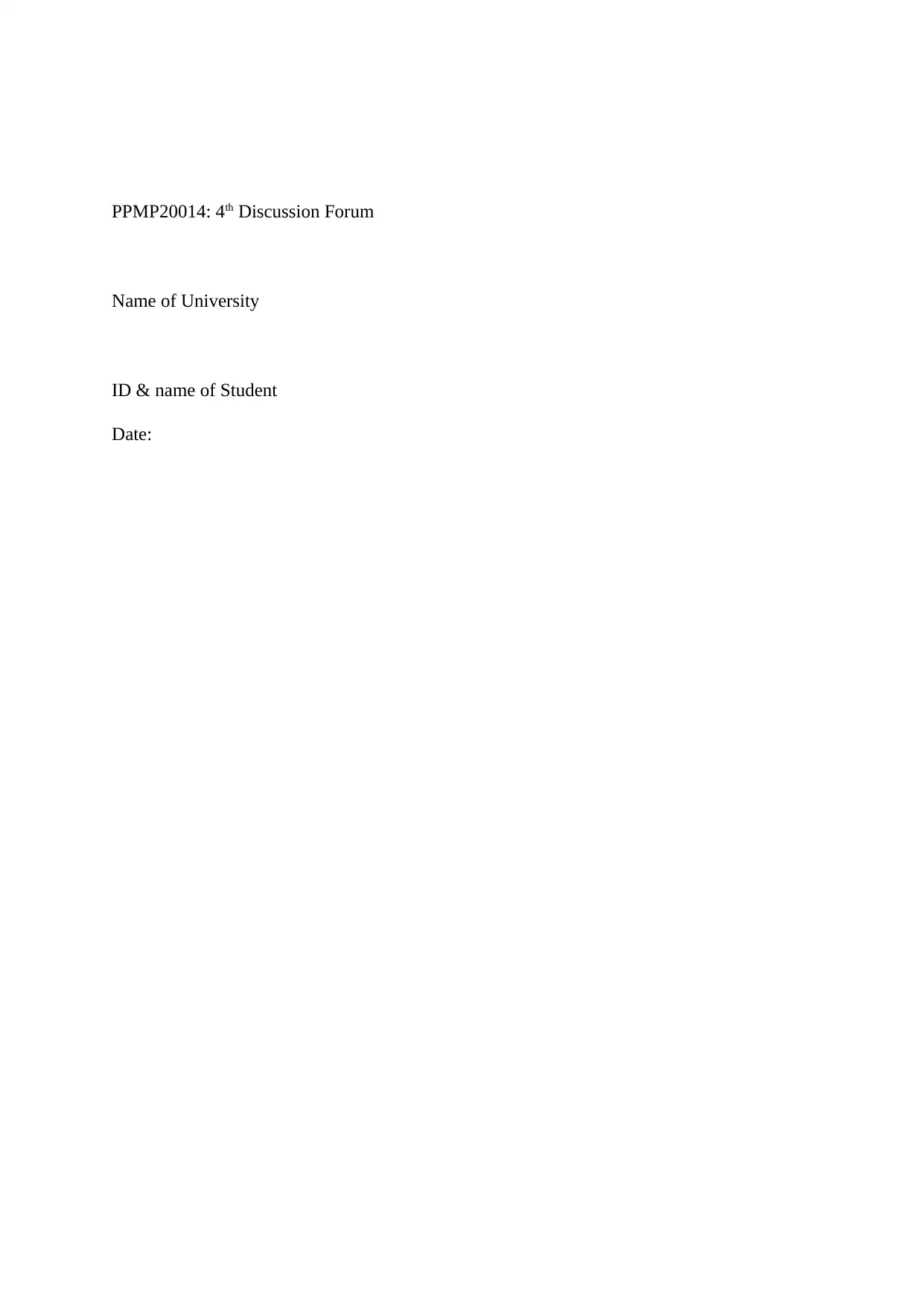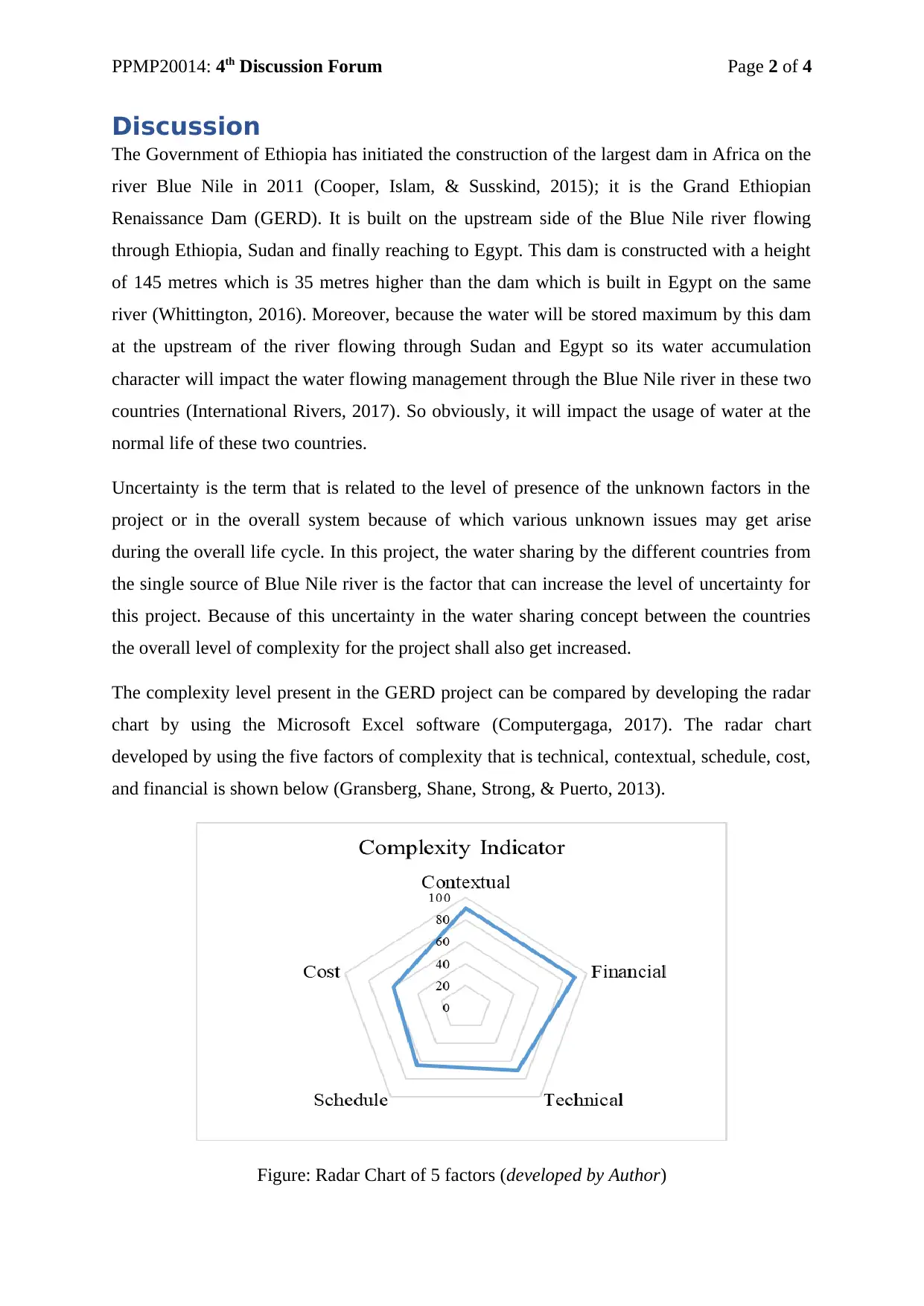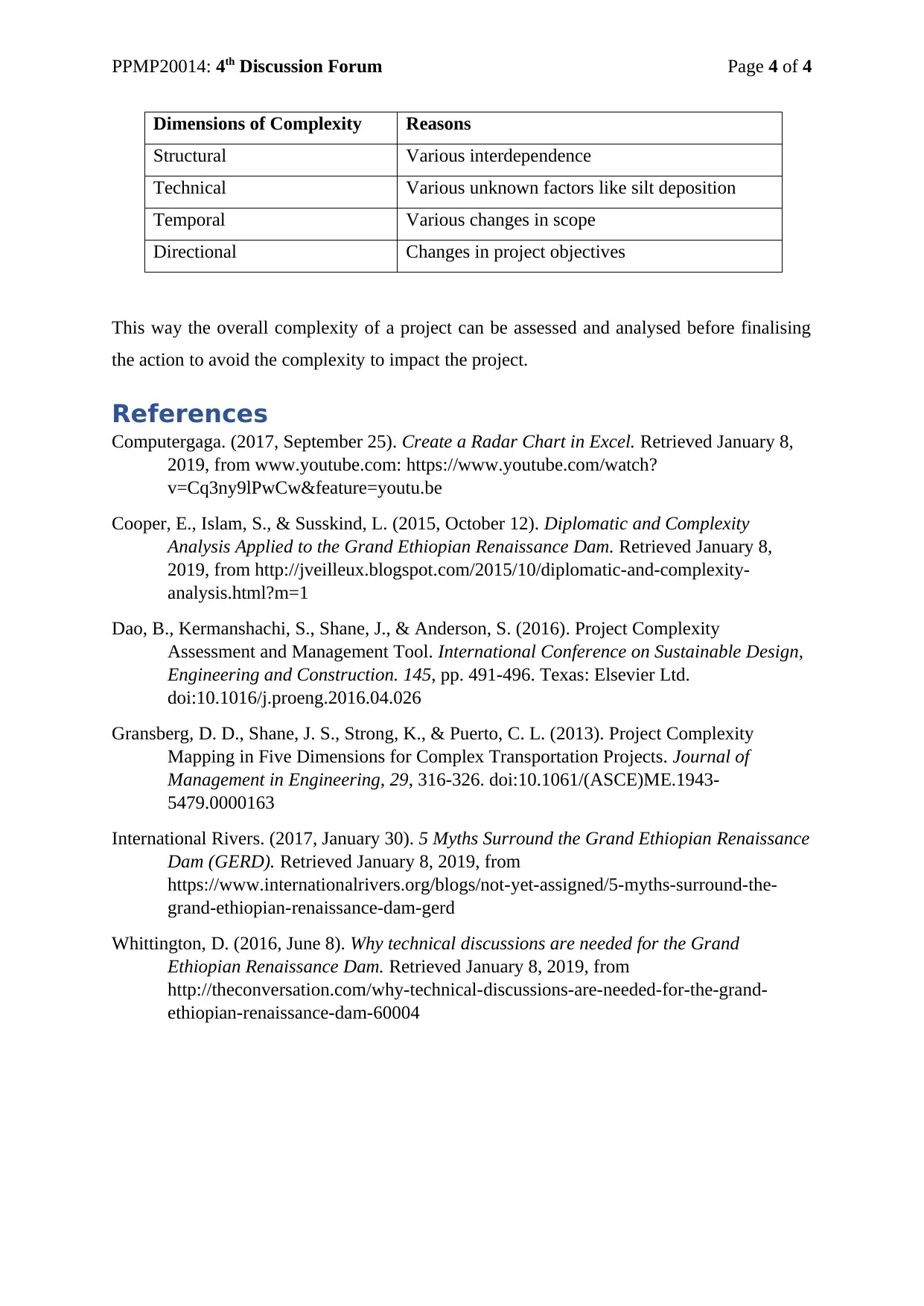PPMP20014 Discussion: Assessment of Project Complexity in GERD
VerifiedAdded on 2023/04/21
|4
|908
|185
Discussion Board Post
AI Summary
This discussion forum post analyzes the complexities associated with the Grand Ethiopian Renaissance Dam (GERD) project, focusing on factors such as water sharing uncertainty between Ethiopia, Sudan, and Egypt. It employs radar charts, developed using Microsoft Excel, to visually represent th...

PPMP20014: 4th Discussion Forum
Name of University
ID & name of Student
Date:
Name of University
ID & name of Student
Date:
Paraphrase This Document
Need a fresh take? Get an instant paraphrase of this document with our AI Paraphraser

PPMP20014: 4th Discussion Forum Page 2 of 4
Discussion
The Government of Ethiopia has initiated the construction of the largest dam in Africa on the
river Blue Nile in 2011 (Cooper, Islam, & Susskind, 2015); it is the Grand Ethiopian
Renaissance Dam (GERD). It is built on the upstream side of the Blue Nile river flowing
through Ethiopia, Sudan and finally reaching to Egypt. This dam is constructed with a height
of 145 metres which is 35 metres higher than the dam which is built in Egypt on the same
river (Whittington, 2016). Moreover, because the water will be stored maximum by this dam
at the upstream of the river flowing through Sudan and Egypt so its water accumulation
character will impact the water flowing management through the Blue Nile river in these two
countries (International Rivers, 2017). So obviously, it will impact the usage of water at the
normal life of these two countries.
Uncertainty is the term that is related to the level of presence of the unknown factors in the
project or in the overall system because of which various unknown issues may get arise
during the overall life cycle. In this project, the water sharing by the different countries from
the single source of Blue Nile river is the factor that can increase the level of uncertainty for
this project. Because of this uncertainty in the water sharing concept between the countries
the overall level of complexity for the project shall also get increased.
The complexity level present in the GERD project can be compared by developing the radar
chart by using the Microsoft Excel software (Computergaga, 2017). The radar chart
developed by using the five factors of complexity that is technical, contextual, schedule, cost,
and financial is shown below (Gransberg, Shane, Strong, & Puerto, 2013).
Figure: Radar Chart of 5 factors (developed by Author)
Discussion
The Government of Ethiopia has initiated the construction of the largest dam in Africa on the
river Blue Nile in 2011 (Cooper, Islam, & Susskind, 2015); it is the Grand Ethiopian
Renaissance Dam (GERD). It is built on the upstream side of the Blue Nile river flowing
through Ethiopia, Sudan and finally reaching to Egypt. This dam is constructed with a height
of 145 metres which is 35 metres higher than the dam which is built in Egypt on the same
river (Whittington, 2016). Moreover, because the water will be stored maximum by this dam
at the upstream of the river flowing through Sudan and Egypt so its water accumulation
character will impact the water flowing management through the Blue Nile river in these two
countries (International Rivers, 2017). So obviously, it will impact the usage of water at the
normal life of these two countries.
Uncertainty is the term that is related to the level of presence of the unknown factors in the
project or in the overall system because of which various unknown issues may get arise
during the overall life cycle. In this project, the water sharing by the different countries from
the single source of Blue Nile river is the factor that can increase the level of uncertainty for
this project. Because of this uncertainty in the water sharing concept between the countries
the overall level of complexity for the project shall also get increased.
The complexity level present in the GERD project can be compared by developing the radar
chart by using the Microsoft Excel software (Computergaga, 2017). The radar chart
developed by using the five factors of complexity that is technical, contextual, schedule, cost,
and financial is shown below (Gransberg, Shane, Strong, & Puerto, 2013).
Figure: Radar Chart of 5 factors (developed by Author)

PPMP20014: 4th Discussion Forum Page 3 of 4
Factors of
Complexity
Description
Contextual The problem between the countries for managing the water
sharing can raise the level of complexity.
Financial Due to the influence of these two countries, unavailability of
required finance has raised the level of complexity
Technical The area is not suitable because of high soil erosion factor
has raised the level of complexity
Schedule Due to multiple levels of negotiations, the schedule factor
has raised the level of complexity
Cost The unavailability of an appropriate fund and the change in
technical factors has raised the level of complexity
For the comparison purpose of developing the assessment for the level of complexity present
in a project, other than these five factors presented above, there are various other complexity
indicators and criteria which can also be applied and are relevant with the structural
dimension, temporal dimension, directional dimension, and the technical dimension of the
complexity and bifurcate in three categories of low, medium and high (Dao, Kermanshachi,
Shane, & Anderson, 2016). These complexities are present in the case study project of
developing the dam on the river Blue Nile in the border of Sudan and Ethiopia. The radar
chart developed by using the four dimensions of complexity is shown below.
Figure: Radar Chart of 4 dimensions of complexity (developed by Author)
Factors of
Complexity
Description
Contextual The problem between the countries for managing the water
sharing can raise the level of complexity.
Financial Due to the influence of these two countries, unavailability of
required finance has raised the level of complexity
Technical The area is not suitable because of high soil erosion factor
has raised the level of complexity
Schedule Due to multiple levels of negotiations, the schedule factor
has raised the level of complexity
Cost The unavailability of an appropriate fund and the change in
technical factors has raised the level of complexity
For the comparison purpose of developing the assessment for the level of complexity present
in a project, other than these five factors presented above, there are various other complexity
indicators and criteria which can also be applied and are relevant with the structural
dimension, temporal dimension, directional dimension, and the technical dimension of the
complexity and bifurcate in three categories of low, medium and high (Dao, Kermanshachi,
Shane, & Anderson, 2016). These complexities are present in the case study project of
developing the dam on the river Blue Nile in the border of Sudan and Ethiopia. The radar
chart developed by using the four dimensions of complexity is shown below.
Figure: Radar Chart of 4 dimensions of complexity (developed by Author)
⊘ This is a preview!⊘
Do you want full access?
Subscribe today to unlock all pages.

Trusted by 1+ million students worldwide

PPMP20014: 4th Discussion Forum Page 4 of 4
Dimensions of Complexity Reasons
Structural Various interdependence
Technical Various unknown factors like silt deposition
Temporal Various changes in scope
Directional Changes in project objectives
This way the overall complexity of a project can be assessed and analysed before finalising
the action to avoid the complexity to impact the project.
References
Computergaga. (2017, September 25). Create a Radar Chart in Excel. Retrieved January 8,
2019, from www.youtube.com: https://www.youtube.com/watch?
v=Cq3ny9lPwCw&feature=youtu.be
Cooper, E., Islam, S., & Susskind, L. (2015, October 12). Diplomatic and Complexity
Analysis Applied to the Grand Ethiopian Renaissance Dam. Retrieved January 8,
2019, from http://jveilleux.blogspot.com/2015/10/diplomatic-and-complexity-
analysis.html?m=1
Dao, B., Kermanshachi, S., Shane, J., & Anderson, S. (2016). Project Complexity
Assessment and Management Tool. International Conference on Sustainable Design,
Engineering and Construction. 145, pp. 491-496. Texas: Elsevier Ltd.
doi:10.1016/j.proeng.2016.04.026
Gransberg, D. D., Shane, J. S., Strong, K., & Puerto, C. L. (2013). Project Complexity
Mapping in Five Dimensions for Complex Transportation Projects. Journal of
Management in Engineering, 29, 316-326. doi:10.1061/(ASCE)ME.1943-
5479.0000163
International Rivers. (2017, January 30). 5 Myths Surround the Grand Ethiopian Renaissance
Dam (GERD). Retrieved January 8, 2019, from
https://www.internationalrivers.org/blogs/not-yet-assigned/5-myths-surround-the-
grand-ethiopian-renaissance-dam-gerd
Whittington, D. (2016, June 8). Why technical discussions are needed for the Grand
Ethiopian Renaissance Dam. Retrieved January 8, 2019, from
http://theconversation.com/why-technical-discussions-are-needed-for-the-grand-
ethiopian-renaissance-dam-60004
Dimensions of Complexity Reasons
Structural Various interdependence
Technical Various unknown factors like silt deposition
Temporal Various changes in scope
Directional Changes in project objectives
This way the overall complexity of a project can be assessed and analysed before finalising
the action to avoid the complexity to impact the project.
References
Computergaga. (2017, September 25). Create a Radar Chart in Excel. Retrieved January 8,
2019, from www.youtube.com: https://www.youtube.com/watch?
v=Cq3ny9lPwCw&feature=youtu.be
Cooper, E., Islam, S., & Susskind, L. (2015, October 12). Diplomatic and Complexity
Analysis Applied to the Grand Ethiopian Renaissance Dam. Retrieved January 8,
2019, from http://jveilleux.blogspot.com/2015/10/diplomatic-and-complexity-
analysis.html?m=1
Dao, B., Kermanshachi, S., Shane, J., & Anderson, S. (2016). Project Complexity
Assessment and Management Tool. International Conference on Sustainable Design,
Engineering and Construction. 145, pp. 491-496. Texas: Elsevier Ltd.
doi:10.1016/j.proeng.2016.04.026
Gransberg, D. D., Shane, J. S., Strong, K., & Puerto, C. L. (2013). Project Complexity
Mapping in Five Dimensions for Complex Transportation Projects. Journal of
Management in Engineering, 29, 316-326. doi:10.1061/(ASCE)ME.1943-
5479.0000163
International Rivers. (2017, January 30). 5 Myths Surround the Grand Ethiopian Renaissance
Dam (GERD). Retrieved January 8, 2019, from
https://www.internationalrivers.org/blogs/not-yet-assigned/5-myths-surround-the-
grand-ethiopian-renaissance-dam-gerd
Whittington, D. (2016, June 8). Why technical discussions are needed for the Grand
Ethiopian Renaissance Dam. Retrieved January 8, 2019, from
http://theconversation.com/why-technical-discussions-are-needed-for-the-grand-
ethiopian-renaissance-dam-60004
1 out of 4
Related Documents
Your All-in-One AI-Powered Toolkit for Academic Success.
+13062052269
info@desklib.com
Available 24*7 on WhatsApp / Email
![[object Object]](/_next/static/media/star-bottom.7253800d.svg)
Unlock your academic potential
© 2024 | Zucol Services PVT LTD | All rights reserved.





